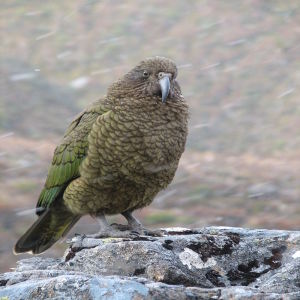 The kea is a large parrot of about 19 inches long and weighing about 1.8 pounds. The kea is the world’s only alpine parrot. It is olive-green in color with a grey beak having a long and narrow curved upper beak. It has orange feathers on the undersides of its wings and orange-red feathers on its back and rump. The kea nests in burrows or crevices among the roots of trees. Keas are known for their intelligence and curiosity. They can solve logical puzzles and work well together to achieve a certain objective. They can prepare and use tools to help them with projects. Keas have been classified as endangered.
The kea is a large parrot of about 19 inches long and weighing about 1.8 pounds. The kea is the world’s only alpine parrot. It is olive-green in color with a grey beak having a long and narrow curved upper beak. It has orange feathers on the undersides of its wings and orange-red feathers on its back and rump. The kea nests in burrows or crevices among the roots of trees. Keas are known for their intelligence and curiosity. They can solve logical puzzles and work well together to achieve a certain objective. They can prepare and use tools to help them with projects. Keas have been classified as endangered.
Location: Animals Formerly at Zoo
Share:
Range
South Island of New Zealand
Habitat
The kea ranges from lowland river valleys and coastal forests of the South Island’s west coast up to the alpine regions of the South Island.
Conservation Status
Endangered
Primary Threats
Human Wildlife Coexistence, Climate Change
Gestation
Incubation time for keas is around 21 days and a brooding period of 94 days.
Litter
2 -5 eggs are laid at a time. The nests are usually positioned on the ground underneath large beech trees, in rock crevices, or dug burrows between roots. They are accessed by tunnels leading back 1 – 6 meters into a larger chamber.
Behavior
Keas have a natural trusting behavior of humans and are extremely eager to explore new things. They are called “the clown of the mountains” and will investigate all objects around them. They will come to get food scraps, but then will also pick up scarves, or anything that they can lift to investigate later. Lead poisoning from this curious habit, as they also select roofing material and other objects, has been a problem as it leads to the toxicity in the birds. Keas are very social and do not live well by themselves.
Reproduction
The laying period starts in July and reaches into January.
Wild Diet
Keas are omnivores. They will eat over 40 different plants, beetle larvae, other birds, and mammals. They have been known to tear apart nests to get to chicks there to eat. They also will eat any ‘gifts’ offered by humans. It has been reported that keas have attacked larger animals, such as sheep, which have subsequently died because of wounds or because of accident caused by the kea attack.
Zoo Diet

